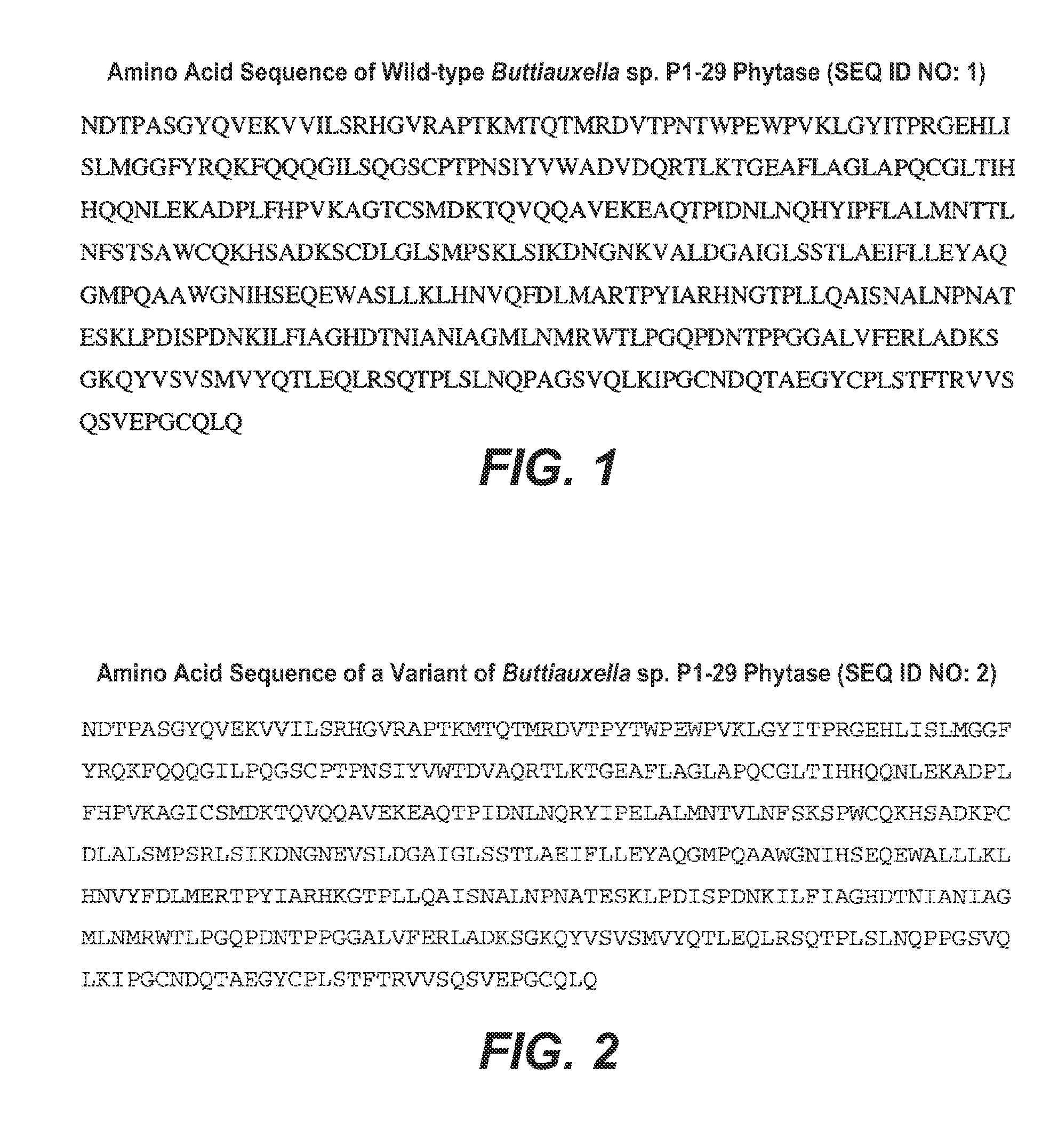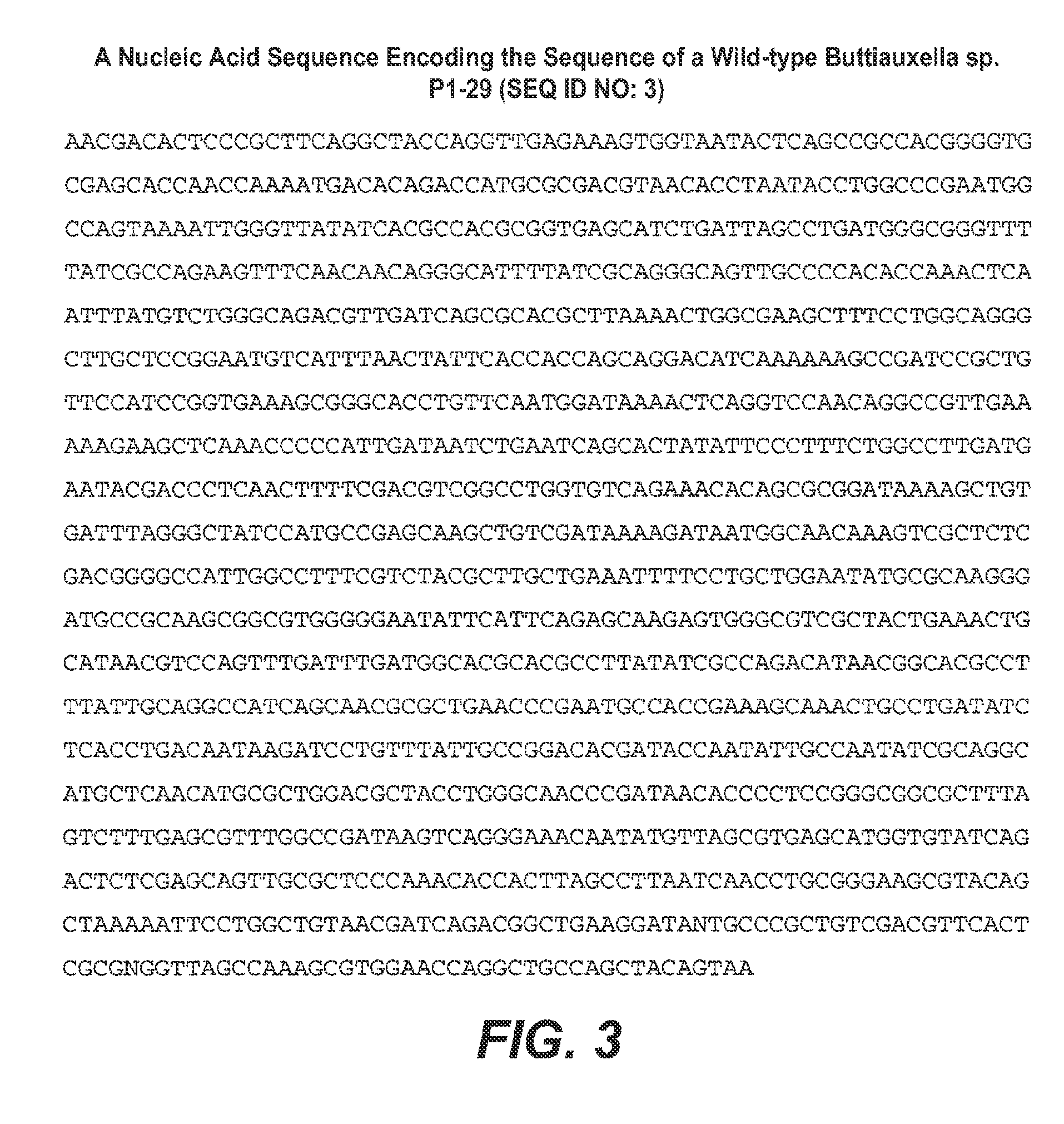Buttiauxella sp. phytase variants
a technology of buttiauxella and phytase, which is applied in the field of improved variants of buttiauxella sp . phytase, can solve the problems of increasing pollution problems and phosphorous pollution in areas of intense livestock production, and achieve the effect of reducing the levels of phosphorus
- Summary
- Abstract
- Description
- Claims
- Application Information
AI Technical Summary
Benefits of technology
Problems solved by technology
Method used
Image
Examples
example 1
Purification of Phytase Enzymes
[0281]Purification of phytase enzymes was performed using a 6His-tag N-terminally fused to the phytase enzymes. B. subtilis, transformed with a plasmid coding for the 6His-tagged phytase enzyme, was cultivated in shake flasks at 37° C. and 160 rpm using standard LB medium with addition of 20 mg / l Neomycin. At this stage, the culture medium accumulated significant amount of phytase activity. About 2 l of the culture broth were adjusted to pH 8.0, filtered and applied to a column packed with 10 ml of Ni-NTA sepharose resin (Qiagen). The column was washed with 50 mM Tris-HCl buffer, 300 mM NaCl, pH 8.0 until OD280 dropped below 0.05. Subsequently the bound phytase was eluted with the same buffer containing 250 mM imidazole hydrochloride. The elutate was dialysed against 50 mM sodium acetate buffer pH 5.0 and stored at 4° C. The enzyme solution was then applied to a Resource S column equilibrated with 20 mM sodium acetate buffer pH 5.0 and the elution was ...
example 2
Phytase Activity Assay
[0282]Phytase assays were carried out in microtiter plates. The reaction had a total volume of 100 microliter containing buffer, as described below, 10 mM phytate, 1 mM calcium chloride and 0.05% (w / v) Pluronic F68. The reaction was allowed to proceed for 30 minutes at a given temperature, e.g. between 37° C. and 90° C.
[0283]Phosphate liberation from phytate as a measure of the phytase activity was assayed by incubating aliquots of the samples (typically 5 μl) in a total volume of 50 μl of phosphate detection assay for 1 h at 37° C. The assay contained the following compounds at the given final concentrations: 1 M Tris / HCl, pH 7.0, 0.01% (v / v) Triton X-100, 0.025 mM ADHP (MoBiTec, Göttingen, Germany), 0.2 U / ml maltosephosphorylase, 0.25 mM maltose, 1.25 U / ml glucose oxidase, 0.25 U / ml horseradish peroxidase, 1 mM EDTA, 0.35 mg / ml BSA. The reaction was stopped by the addition of 30 μl of 2700 U / ml catalase in H2O. Subsequently the fluorescence at 595 nm was meas...
example 3
Specific Activity
[0285]The specific activity of BP-WT and variant phytase enzymes was estimated using the purified enzymes according to example 1.
[0286]Phytase activity was determined in microtiter plates using a coupled enzymatic assay: Enzyme preparations were diluted in dilution buffer (50 mM sodium acetate, 0.05% Pluronic F-68, 1 mg / ml BSA). An aliquot of the enzyme solution, typically 5 μl to 10 μl was incubated in the phytate assay with a total volume of 80 The assay contains the following buffers, substrates and salts at the given final concentrations: 200 mM sodium acetate, pH 5.5, 10 mM phytate, 1 mM CaCl2, 0.05% (w / v) Pluronic F-68). The assays were incubated for 30 min at 37° C. in the case of the BP-WT phytase and for 30 min at 67° C. or 80° C. in the case of the variant phytase enzymes.
[0287]Phosphate liberation from phytate as a measure of the phytase activity was assayed by incubating aliquots of the respective samples (typically 5 μl) in a total volume of 50 μl of ph...
PUM
| Property | Measurement | Unit |
|---|---|---|
| temperature | aaaaa | aaaaa |
| elevated temperature | aaaaa | aaaaa |
| temperature | aaaaa | aaaaa |
Abstract
Description
Claims
Application Information
 Login to View More
Login to View More - R&D
- Intellectual Property
- Life Sciences
- Materials
- Tech Scout
- Unparalleled Data Quality
- Higher Quality Content
- 60% Fewer Hallucinations
Browse by: Latest US Patents, China's latest patents, Technical Efficacy Thesaurus, Application Domain, Technology Topic, Popular Technical Reports.
© 2025 PatSnap. All rights reserved.Legal|Privacy policy|Modern Slavery Act Transparency Statement|Sitemap|About US| Contact US: help@patsnap.com



